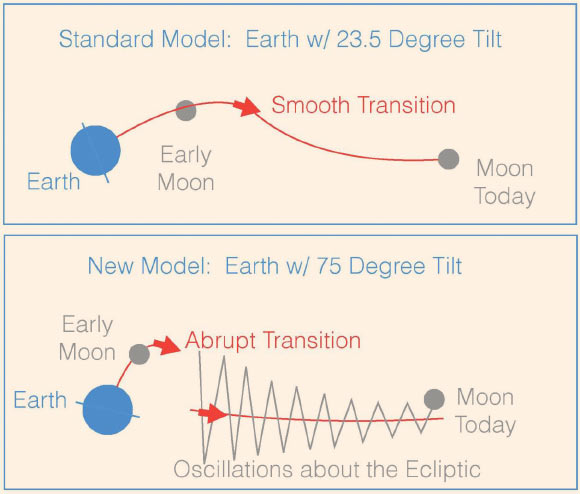Earth’s Moon is among the strangest planetary bodies in our Solar System. Its orbit lies unusually far away from our planet, with a surprisingly large orbital tilt. And now there’s a new theory to explain how it got where it is, which puts some twists on the widely-accepted ‘giant-impact’ theory.

This is an artist’s depiction of a catastrophic collision between two celestial bodies; such an impact between the proto-Earth and Theia likely formed the Moon. Image credit: NASA / JPL-Caltech.
The textbook giant-impact theory goes like this: late in the formation of the Solar System came the giant-impact phase, when hot protoplanets collided with each other.
An object the size of Mars, known as Theia, grazed what would become Earth, throwing off a mass of material from which the Moon condensed. This impact set the angular momentum for the Earth-Moon system, and gave the early Earth a 5-hour day.
Over millennia, the Moon has receded from the Earth and the rotation has slowed to our current 24-hour day.
Planetary researchers have figured this out by looking at the Moon’s current orbit, working out how rapidly angular momentum of the Earth-Moon system has been transferred by the tidal forces between the two objects, and working backwards.
But there are a couple of problems with this theory.
One is the Moon’s surprisingly Earth-like composition. Another is that if the Moon condensed from a disk of material rotating around Earth’s equator, it should be in orbit over the equator.
But the Moon’s current orbit is tilted 5 degrees off the equator, meaning some more energy must have been put in to move it.
“This large tilt is very unusual. Until now, there hasn’t been a good explanation. But we can understand it if the Earth had a more dramatic early history than we previously suspected,” said co-author Prof. Douglas Hamilton, from the University of Maryland.
“The Moon is relatively big compared to the planet it orbits, and it’s made of almost the same stuff, minus some more volatile compounds that evaporated long ago. That makes it distinct from every other major object in the Solar System,” said senior author Prof. Sarah Stewart, from the University of California, Davis.
“Every other body in the Solar System has different chemistry.”

In the giant-impact model of the Moon’s formation, the young Moon began its orbit within Earth’s equatorial plane. In the standard variant of this model (top panel), Earth’s tilt began near today’s value of 23.5 degrees. The Moon would have moved outward smoothly along a path that slowly changed from the equatorial plane to the ‘ecliptic’ plane, defined by Earth’s orbit around the Sun. If, however, Earth had a much larger tilt after the impact (about 75 degrees, lower panel) then the transition between the equatorial and ecliptic planes would have been abrupt, resulting in large oscillations about the ecliptic. The second picture is consistent with the Moon’s current 5-degree orbital tilt away from the ecliptic. Image credit: Douglas Hamilton.
Prof. Hamilton, Prof. Stewart and their colleagues, Dr. Matija Cuk of SETI Institute and Dr. Simon Lock of Harvard University, tried many different scenarios.
But the most successful one involved a Moon-forming impact that sent the Earth spinning extremely fast — as much as twice the rate predicted by other models. The impact also knocked the Earth’s tilt way off, to somewhere between 60 and 80 degrees.
“We already suspected that the Earth must have spun especially fast after the impact. An early high tilt for Earth enables our planet to lose that excess spin more readily,” Dr. Cuk said.
The team’s model also suggests that the newborn Moon started off very close to Earth, but then drifted away — to nearly 15 times its initial distance. As it did so, the Sun began to exert a more powerful influence over the Moon’s orbit.
Both factors — a highly tilted, fast spinning Earth and an outwardly-migrating Moon — contributed to establishing the Moon’s current weird orbit.
The early Moon’s orbit most likely tracked the Earth’s equator, tilted at a steep 60-80 degree angle that matched Earth’s tilt.
A key finding of the study is that, if the Earth was indeed tilted by more than 60 degrees after the Moon formed, the Moon could not transition smoothly from Earth’s equatorial plane to the ecliptic plane. Instead, the transition was abrupt and left the Moon with a large tilt relative to the ecliptic — much larger than is observed today.
“As the Moon moved outward, the Earth’s steep tilt made for a more chaotic transition as the Sun became a bigger influence,” Dr. Cuk said.
“Subsequently, and over billions of years, the Moon’s tilt slowly decayed down to the 5 degrees we see today. So today’s 5-degree orbital tilt is a relic and a signature of a much steeper tilt in the past.”
The results were published online Oct. 31 in the journal Nature.
_____
Matija Ćuk et al. Tidal evolution of the Moon from a high-obliquity, high-angular-momentum Earth. Nature, published online October 31, 2016; doi: 10.1038/nature19846







